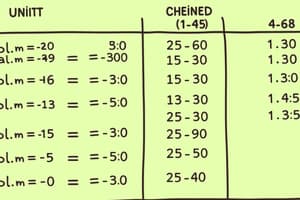Podcast
Questions and Answers
What is the approximate weight of a US Ton in kilograms?
What is the approximate weight of a US Ton in kilograms?
- 907.185kg (correct)
- 1016kg
- 2204.62lbs
- 2240lbs
According to the content, how many kilograms are in one hundredweight?
According to the content, how many kilograms are in one hundredweight?
- 1016kg
- 2240lbs
- 50kg (correct)
- 1000kg
What is the approximate weight, in kilograms, of an Imperial Ton (or 'long Ton' in the USA)
What is the approximate weight, in kilograms, of an Imperial Ton (or 'long Ton' in the USA)
- 1016kg (correct)
- 2000lbs
- 907.185kg
- 2204.62lbs
Which of the following units is NOT a base unit in the International System of Units (SI)?
Which of the following units is NOT a base unit in the International System of Units (SI)?
Which of these commonly used weight units uses the symbol ‘t’?
Which of these commonly used weight units uses the symbol ‘t’?
When marking lifting equipment, what is the maximum decimal place allowed for fractions of a tonne according to the SI system?
When marking lifting equipment, what is the maximum decimal place allowed for fractions of a tonne according to the SI system?
What is the equivalent of 2.5t in terms of kilograms?
What is the equivalent of 2.5t in terms of kilograms?
Which of the following conversion is NOT correct based on the content provided?
Which of the following conversion is NOT correct based on the content provided?
Which crack detection method is considered more accurate and efficient than dye penetrant?
Which crack detection method is considered more accurate and efficient than dye penetrant?
What is the main purpose of dye penetrant crack detection?
What is the main purpose of dye penetrant crack detection?
Which crack detection method is particularly suitable for inspecting large areas efficiently?
Which crack detection method is particularly suitable for inspecting large areas efficiently?
Which crack detection method is considered most effective for detecting surface flaws in ferrous materials?
Which crack detection method is considered most effective for detecting surface flaws in ferrous materials?
What is the primary reason for using high-tech software and detection equipment in eddy current testing?
What is the primary reason for using high-tech software and detection equipment in eddy current testing?
Which crack detection method is best suited for detecting internal defects, such as voids or inclusions, within a material?
Which crack detection method is best suited for detecting internal defects, such as voids or inclusions, within a material?
What is the primary difference between dye penetrant and MPI crack detection?
What is the primary difference between dye penetrant and MPI crack detection?
Which of the following crack detection methods require trained operatives to interpret the results?
Which of the following crack detection methods require trained operatives to interpret the results?
What is the working load limit (WLL) of a two-leg sling with an included angle of 110 degrees, in relation to the WLL of a single leg?
What is the working load limit (WLL) of a two-leg sling with an included angle of 110 degrees, in relation to the WLL of a single leg?
What is the working load limit (WLL) of a four-leg sling with an included angle of 30 degrees, in relation to the WLL of a single leg?
What is the working load limit (WLL) of a four-leg sling with an included angle of 30 degrees, in relation to the WLL of a single leg?
Which of the following statements accurately describes the working load limit of a four-leg sling according to the content?
Which of the following statements accurately describes the working load limit of a four-leg sling according to the content?
Which of the following is a potential danger associated with three-leg slings at angles greater than 90 degrees?
Which of the following is a potential danger associated with three-leg slings at angles greater than 90 degrees?
What is the maximum working load limit (WLL) of a multi-leg sling with more than two legs in Australia?
What is the maximum working load limit (WLL) of a multi-leg sling with more than two legs in Australia?
What is the recommended included angle for a two-leg sling when calculating its working load limit (WLL)?
What is the recommended included angle for a two-leg sling when calculating its working load limit (WLL)?
Which of the following sling configurations is NOT mentioned in the content as having a specific working load limit?
Which of the following sling configurations is NOT mentioned in the content as having a specific working load limit?
What is the primary reason for the lower working load limit of a two-leg sling at angles greater than 45 degrees?
What is the primary reason for the lower working load limit of a two-leg sling at angles greater than 45 degrees?
What is the equivalent of 2 Ton 1 cwt in kilograms?
What is the equivalent of 2 Ton 1 cwt in kilograms?
What is the generally accepted rule for marking the SWL of equipment less than one tonne or Ton?
What is the generally accepted rule for marking the SWL of equipment less than one tonne or Ton?
Which of the following is considered an important legal document associated with new equipment?
Which of the following is considered an important legal document associated with new equipment?
What is the major reason why proof load testing might not be suitable for some equipment?
What is the major reason why proof load testing might not be suitable for some equipment?
Which type of lifting equipment is mentioned as often being verified by its individual components rather than requiring additional testing?
Which type of lifting equipment is mentioned as often being verified by its individual components rather than requiring additional testing?
Which of the following is NOT mentioned as a requirement for new equipment to comply with?
Which of the following is NOT mentioned as a requirement for new equipment to comply with?
How is the SWL of new equipment typically expressed?
How is the SWL of new equipment typically expressed?
In the context of lifting accessories, what does 'SWL' stand for?
In the context of lifting accessories, what does 'SWL' stand for?
What method is recommended for rating multipurpose slings to ensure safety?
What method is recommended for rating multipurpose slings to ensure safety?
How is the working load limit (WLL) for a two-leg sling calculated?
How is the working load limit (WLL) for a two-leg sling calculated?
Which statement about slings designed for a single purpose is correct?
Which statement about slings designed for a single purpose is correct?
What must be done if a multi-leg sling is used with fewer legs than its designed capacity?
What must be done if a multi-leg sling is used with fewer legs than its designed capacity?
What is one benefit of the uniform load method of rating slings?
What is one benefit of the uniform load method of rating slings?
What is a common misconception about the trigonometric method for rating slings?
What is a common misconception about the trigonometric method for rating slings?
Why is the uniform load method favored by many national and international standards?
Why is the uniform load method favored by many national and international standards?
When should the trigonometric method still be considered for slings?
When should the trigonometric method still be considered for slings?
What is the required accuracy for chain testing according to BS EN 818-1?
What is the required accuracy for chain testing according to BS EN 818-1?
According to ISO 7500-1, how often should test machines and load cells be calibrated and verified by a competent person or authority?
According to ISO 7500-1, how often should test machines and load cells be calibrated and verified by a competent person or authority?
What is the maximum allowable inaccuracy for applied load/force during testing, according to the text?
What is the maximum allowable inaccuracy for applied load/force during testing, according to the text?
What does "Grade 0.5" refer to in the text?
What does "Grade 0.5" refer to in the text?
What is the "Lower Limit of Calibration"?
What is the "Lower Limit of Calibration"?
What is the main responsibility of the person performing a load test, as outlined in the text?
What is the main responsibility of the person performing a load test, as outlined in the text?
What does LEEA Technical Requirements emphasize regarding measuring devices?
What does LEEA Technical Requirements emphasize regarding measuring devices?
What is the most likely type of verification required for tapes and rules, according to the text?
What is the most likely type of verification required for tapes and rules, according to the text?
Flashcards
Unit of Measure
Unit of Measure
A standardized quantity used to determine multiple quantities of a physical property.
International System of Units (SI)
International System of Units (SI)
The most widely used system of units that includes seven base units from which all other units are derived.
SI Base Units
SI Base Units
The seven fundamental units in the International System, which are used to derive all other units.
Kilogram (kg)
Kilogram (kg)
Signup and view all the flashcards
Tonne (t)
Tonne (t)
Signup and view all the flashcards
Imperial Ton
Imperial Ton
Signup and view all the flashcards
Hundredweight (cwt)
Hundredweight (cwt)
Signup and view all the flashcards
US Ton (Short Ton)
US Ton (Short Ton)
Signup and view all the flashcards
SWL
SWL
Signup and view all the flashcards
1 Ton
1 Ton
Signup and view all the flashcards
Load Limit Conversion
Load Limit Conversion
Signup and view all the flashcards
Verification Methods
Verification Methods
Signup and view all the flashcards
New Equipment Verification
New Equipment Verification
Signup and view all the flashcards
Proof Load Testing
Proof Load Testing
Signup and view all the flashcards
Conformity Documentation
Conformity Documentation
Signup and view all the flashcards
Verification Types
Verification Types
Signup and view all the flashcards
Test Machines
Test Machines
Signup and view all the flashcards
Force Measuring Equipment
Force Measuring Equipment
Signup and view all the flashcards
Calibration
Calibration
Signup and view all the flashcards
ISO 7500-1
ISO 7500-1
Signup and view all the flashcards
Accuracy Levels
Accuracy Levels
Signup and view all the flashcards
Lower Limit of Calibration
Lower Limit of Calibration
Signup and view all the flashcards
Load Testing Awareness
Load Testing Awareness
Signup and view all the flashcards
Uniform Load Method
Uniform Load Method
Signup and view all the flashcards
Working Load Limit (WLL)
Working Load Limit (WLL)
Signup and view all the flashcards
Trigonometric Method
Trigonometric Method
Signup and view all the flashcards
Multi-Leg Sling
Multi-Leg Sling
Signup and view all the flashcards
Rating Reduction for Legs
Rating Reduction for Legs
Signup and view all the flashcards
Single Leg Sling Calculation
Single Leg Sling Calculation
Signup and view all the flashcards
Cosine Adjustment
Cosine Adjustment
Signup and view all the flashcards
Safety Standards for Slings
Safety Standards for Slings
Signup and view all the flashcards
Precision Measuring Equipment
Precision Measuring Equipment
Signup and view all the flashcards
Crack Detection
Crack Detection
Signup and view all the flashcards
Basic Crack Detection Methods
Basic Crack Detection Methods
Signup and view all the flashcards
Dye Penetrant Testing
Dye Penetrant Testing
Signup and view all the flashcards
Magnetic Particle Inspection (MPI)
Magnetic Particle Inspection (MPI)
Signup and view all the flashcards
Eddy Current Testing
Eddy Current Testing
Signup and view all the flashcards
Radiography
Radiography
Signup and view all the flashcards
Ultrasonic Testing
Ultrasonic Testing
Signup and view all the flashcards
Single Leg Sling WLL
Single Leg Sling WLL
Signup and view all the flashcards
Two Leg Sling WLL (0-45°)
Two Leg Sling WLL (0-45°)
Signup and view all the flashcards
Two Leg Sling WLL (45°-60°)
Two Leg Sling WLL (45°-60°)
Signup and view all the flashcards
Three/Four Leg Sling WLL (0-45°)
Three/Four Leg Sling WLL (0-45°)
Signup and view all the flashcards
Three/Four Leg Sling WLL (45°-60°)
Three/Four Leg Sling WLL (45°-60°)
Signup and view all the flashcards
Multipurpose Four-Leg Sling
Multipurpose Four-Leg Sling
Signup and view all the flashcards
National Standards for Slings
National Standards for Slings
Signup and view all the flashcards
WLL Limit in Australia
WLL Limit in Australia
Signup and view all the flashcards
Study Notes
Units of Measure
- A unit of measure is a standardized quantity of a physical property used to determine multiple quantities of that property.
- Examples include weight, length, mass, and force.
- Different systems of units are based on fundamental units.
- The International System of Units (SI) is the most widely used system, with seven base units.
- Other SI units are derived from these base units.
- When marking lifting equipment using the SI system, fractions of a tonne (e.g., 2.1t) use one decimal place, except for 0.25t, which uses two decimal places (e.g., 2.25t).
Symbols and Conversions
- Ton (US): T = 2000 lbs = 907.185 kg = 0.907t (metric)
- Tonne (Metric): t = 1000 kg = 2204.62 lbs
- Ton (Imperial): 1016 kg = 2240 lbs
- Hundredweight (cwt): 50 kg
Other Useful Conversions
- 1 kg = 2.2 lbs
- 1 inch = 25.4 mm
- 1 foot = 12 inches
- 10 kN ≈ 1000 kg
Types of Verification
- Verification of lifting equipment ensures it meets standards, legal requirements, and safety.
- Verification procedures include proof load tests, non-destructive tests, calculations, and thorough examinations.
Test Machines and Force/Load Measuring Equipment
- Product standards often specify the accuracy required for load or force applications.
- Calibration and verification of test machines and load cells must be performed by a competent person.
- ISO 7500-1 defines various classes of machines with different levels of accuracy (e.g., 0.5, 1.0, 2.0).
- Certificates of calibration and verification indicate accuracy information.
- The Lower Limit of Calibration (load/force) is the minimum value that can be measured within the required accuracy.
Dimensional Measuring Equipment
- Basic measuring equipment, such as tapes and rules, is often used.
- Graduation should be based on national standards, in 1 mm increments for standard items, and 0.1 mm for general lifting equipment using vernier gauges.
Crack Detection
- Basic crack detection methods like dye penetrant or magnetic particle inspection are common.
- More detailed methods like eddy current, radiography, and ultrasonic inspections are used for high-value or specialized scenarios, needing more advanced training.
Hardness - Brinell Testing
- Measuring equipment hardness using indentations (Vickers, Brinell, Rockwell) is performed, often after heat treatments.
- Brinell is a standard method in lifting equipment manufacturing.
Marking Lifting Equipment
- Permanent markings are essential.
- Marking should occur in low-stress areas to prevent damage.
- Use suitable materials (plate, metal tab, etc.).
- Ensure compliance with applicable standards for sizing and location of markings.
Trigonometry of Slinging
- Increased angles between sling legs in multi-leg slings results in increased load on the respective legs.
- Uniform load method ratings exist for different angles and are commonly marked using included angle. Slings can also be rated for angle to the vertical.
- Trigonometric method, while previously common, may be less common now and depends on existing standards.
Mode Factor
- A mode factor, calculated using the cosine of the angle from vertical to the sling leg, is used to determine the new working load limit (WLL) of a sling.
- This factor usually modifies the WLL of single sling legs to reflect their contribution to the overall load in multi-leg or multi-sling applications.
Multi-Leg Sling User Information
- When fewer legs are attached to a load, the WLL should be proportionally reduced.
- Proper rating of lifting accessories, including multi-leg slings, are essential to ensure safe operations.
Studying That Suits You
Use AI to generate personalized quizzes and flashcards to suit your learning preferences.




